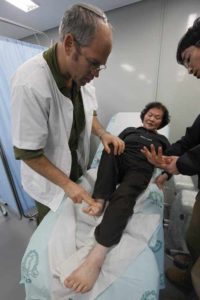
By Karen Kaplan, Los Angeles TimesApril 15, 2011, 6:00 a.m.
Natural disasters – such as the earthquake and tsunami in Japan – are horrible events any way you slice them. But sometimes there’s a small silver lining: The medical personnel who respond to these emergencies often learn valuable lessons that they can pass along to others who may tend to the victims of future disasters.
This week, a team of doctors from the Israeli Defense Forces Medical Corps shared some of what they learned about crush syndrome after treating 126 patients who suffered from it as a result of the January 2010 earthquake in Haiti.
In crush syndrome, an injury to a single part of the body can cause problems elsewhere in the body because damaged muscles release toxic chemicals and electrolytes into the blood. According to the Centers for Disease Control and Prevention’s primer on crush syndrome, it “can cause local tissue injury, organ dysfunction, and metabolic abnormalities, including acidosis, hyperkalemia, and hypocalcemia.”
The CDC also notes that 2% to 15% of people who experience earthquakes causing “major structural damage” wind up with crush syndrome, and that half of them develop acute renal failure. (Californians, they’re talking to you.)
The Israeli doctors set up a field hospital in Haiti within 89 hours of the magnitude 7.0 quake. They treated a total of 1,111 patients there; 11% of them suffered from some degree of crush syndrome.
The report, published Monday in the Archives of Internal Medicine, focuses on the eight patients who were treated for crush syndrome in the first three days after the field hospital opened. The statistics are rather grim:
- The patients had been trapped beneath rubble for an average of 31 hours (one patient was buried for three whole days).
- All eight patients developed acute renal failure.
- Four of the patients had been crushed in the chest or abdomen, and “most” had “limb involvement.”
- Only two of the patients recovered.
Comparing the survivors with those who didn’t make it, the doctors flagged some clinical characteristics that were associated with poor outcomes. Among them:
- Being trapped under rubble for a long period of time.
- Sustaining an injury to the chest.
- Development of compartment syndrome, a complication in which swelling builds up pressure that prevents blood flow to a muscle, causing permanent damage that may require amputation.
- Passing very little or no urine.
The Israeli doctors noted that the odds of surviving acute renal failure due to a crush injury improve dramatically when patients can get their blood filtered through dialysis. In Haiti, this treatment was not available until the U.S. Navy hospital ship Comfort arrived 10 days after the earthquake.
An introduction to the report, “Crush Syndrome: Saving More Lives in Disasters,” is available online here. (The full study is behind a paywall on LA Times site.)